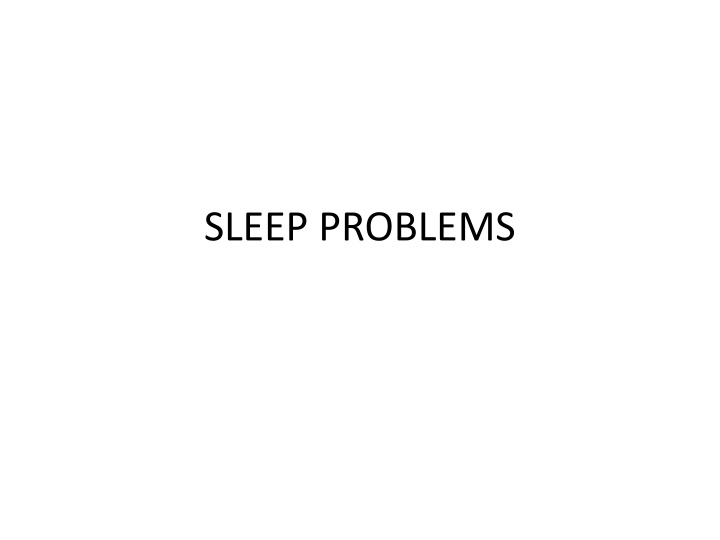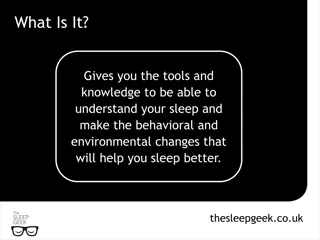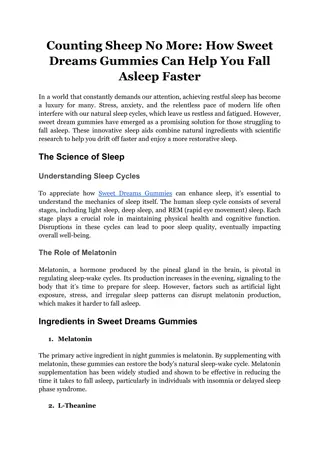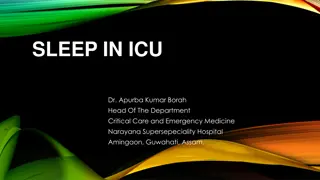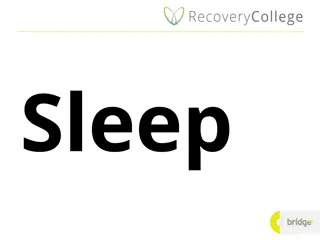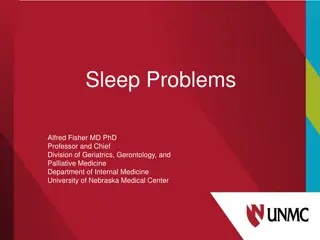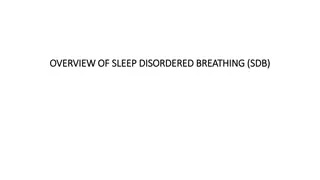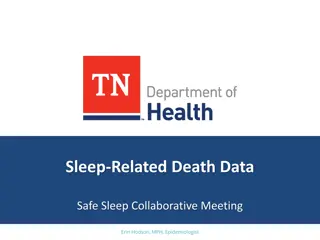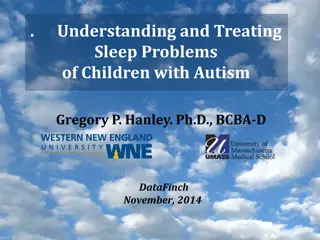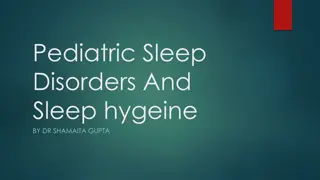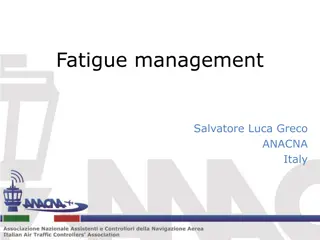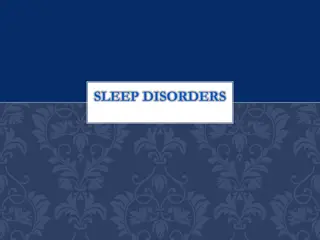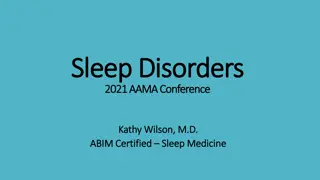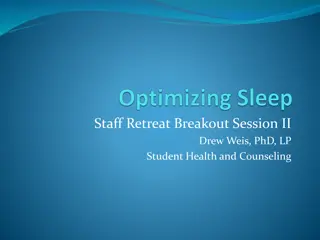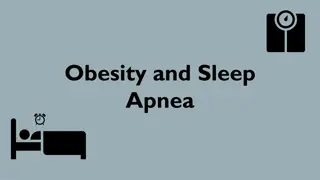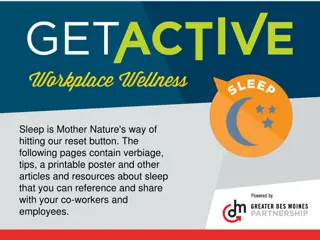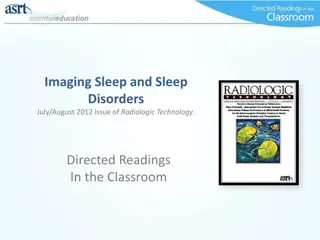Effective Strategies for Managing Sleep Problems in Patients
Equip trainees to address patients’ complaints about sleep problems by defining primary and secondary insomnia, understanding causes and management, taking detailed sleep history, discussing sleep hygiene principles, and exploring drug treatment pros and cons. Learn about the definition of sleep problems, secondary causes like depression and anxiety, and the importance of comprehensive history taking to guide effective patient management strategies.
Download Presentation

Please find below an Image/Link to download the presentation.
The content on the website is provided AS IS for your information and personal use only. It may not be sold, licensed, or shared on other websites without obtaining consent from the author.If you encounter any issues during the download, it is possible that the publisher has removed the file from their server.
You are allowed to download the files provided on this website for personal or commercial use, subject to the condition that they are used lawfully. All files are the property of their respective owners.
The content on the website is provided AS IS for your information and personal use only. It may not be sold, licensed, or shared on other websites without obtaining consent from the author.
E N D
Presentation Transcript
Learning Outcomes Aim To equip the trainee to deal effectively with patients who complain they cannot sleep Objectives By the end of this session the trainee will Be able to define Primary and Secondary Insomnia Have considered the various causes, investigation and management of Secondary Insomnia Be able to take a comprehensive sleep history Have discussed the principles of sleep hygiene , bed time restriction and stimulus control Have practised advising patients with a variety of sleep problems Have discussed the pros and cons of drug treatments
Definition A repeated difficulty with sleep initiation, duration, consolidation or quality that occurs despite adequate time and opportunity for sleep and results in some form of daytime impairment and lasting for at least 1 month. From the American Sleep Disorders Association International Classification of Sleep Disorders Manual Normally people sleep between 7 and 9 hours each night. Sleep requirements fall with age- by 27 minutes per decade from mid life to the 8thdecade
Secondary Causes Depression Anxiety Physical health problems (e.g. pain/dyspnoea)- 43% Obstructive sleep apnoea Excess alcohol Delayed sleep phase disorder (a circadian rhythm disorder) Illicit drug use Parasomnias (restless legs, sleep walking, sleep terrors, periodic limb movements, sleep related eating disorder, sleep sex) If exclude a secondary cause then Primary Insomnia
HISTORY TAKING Can you describe your problem with sleeping? Does it interfere with functioning the next day? Describe the night: o Time go to bed? o How long to fall asleep? o Awakenings and causes o Last awakening in morning o Time of rising o Usual sleep duration o Different in week/ weekends/ holidays? o Vigorous activity late in the evening?
More History Questions How do you feel on awakening? Are there any symptoms of OAD? (snoring, pauses, gasping) Any factors interfering with sleep? (stimulants, prescribed meds, important life events) Do you take day time naps? Do you experience low mood or worry a lot? Do you experience leg twitching, sleep walking, unusual night time behaviours?
Investigations PHQ-9, GAD-7, CAGE (alcohol), ASSIST (alcohol, smoking and substance involvement screening test) questionnaires Sleep diaries Physical exam (obese/ PD) TFTs, ferritin, FBC Polysomnography
TREATMENT Treat any underlying condition(s) if secondary insomnia Restless legs: massage, exercise, stretching, warm baths and if fails then non-ergot dopamine antagonists Delayed sleep phase disorder: melatonin and light boxes Refer parasomnias Sleep hygiene for all
SLEEP HYGIENE Limit caffeine and other stimulants Don t go to bed until drowsy and sleepy Don t nap during the day Take regular exercise but not late in the evening Make bedroom conducive to sleep Computers, lit clocks and co-sleepers If not asleep within 15-20 minutes get out of bed and return only when drowsy
Bed time restriction for Primary Insomnia Do a sleep diary (time in bed is more than time asleep) Restrict time in bed to estimated total sleep time Get up with family but go to bed later Do for at least 2 weeks- quality of sleep usually improves If wish add 30 minutes to time in bed each week If no better reduce time in bed (no less than 5h)
Stimulus Control Instructions 1. Go to bed only when sleepy 2. Get out of bed if unable to sleep after 15-20 minutes returning only when sleepy 3. Use the bed/bedroom only for sleep 4. Arise at the same time each day 5. No naps
Medication Behavioural therapies equally as good but benefits longer lasting Benzos and Z drugs Perceived tolerance and dependence ? Max 3 nights per week Less side effects than sedating antidepressants and sedating antipsychotics Melatonin- only useful if circadian rhythm disorder Much better to only resort to medication after behavioural initiatives have failed
Case 1 Mr Bill Jones is a sales executive with impossible targets working 60h a week. He drinks a couple of glasses of red wine each evening to help him relax, but still has difficulty getting to sleep and feels exhausted until after his second cup of coffee the next morning. He smokes 20/day and his BMI is 24. He wants a sleeping tablet.
Case 2 Nurse Smith works shifts- a mixture of day and nights and has 2 young children and a husband a policeman also working shifts She wants sleeping tablets as she struggles to get to sleep
Case 3 Mr Brown is 75y old and widowed last year his children live in the south of England. His eye sight is failing him and arthritis of his hip means he cannot get out as much as he d like. He also gets up to PU 3-4 times a night. He can t sleep and wants help.
Case 4 Jennifer Smith is 34y old and single and works in a library. She is not depressed and otherwise fit and well. She has never felt she needed much sleep but is fed up of lying in bed awake tossing and turning for around 3 hours a night.
